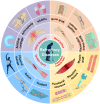Delivering Microrobots in the Musculoskeletal System
- PMID: 39037551
- PMCID: PMC11263536
- DOI: 10.1007/s40820-024-01464-8
Delivering Microrobots in the Musculoskeletal System
Abstract
Disorders of the musculoskeletal system are the major contributors to the global burden of disease and current treatments show limited efficacy. Patients often suffer chronic pain and might eventually have to undergo end-stage surgery. Therefore, future treatments should focus on early detection and intervention of regional lesions. Microrobots have been gradually used in organisms due to their advantages of intelligent, precise and minimally invasive targeted delivery. Through the combination of control and imaging systems, microrobots with good biosafety can be delivered to the desired area for treatment. In the musculoskeletal system, microrobots are mainly utilized to transport stem cells/drugs or to remove hazardous substances from the body. Compared to traditional biomaterial and tissue engineering strategies, active motion improves the efficiency and penetration of local targeting of cells/drugs. This review discusses the frontier applications of microrobotic systems in different tissues of the musculoskeletal system. We summarize the challenges and barriers that hinder clinical translation by evaluating the characteristics of different microrobots and finally point out the future direction of microrobots in the musculoskeletal system.
Keywords: Magnetic actuation; Microrobot; Microrobotic systems; Musculoskeletal system; Targeted delivery.
© 2024. The Author(s).
Conflict of interest statement
The authors declare no conflict of interest. They have no known competing financial interests or personal relationships that could have appeared to influence the work reported in this paper.
Figures







References
-
- C. Abbafati, K.M. Abbas, M. Abbasi, M. Abbasifard, M. Abbasi-Kangevari et al., Collaborators global burden of 369 diseases and injuries in 204 countries and territories, 1990–2019: a systematic analysis for the global burden of disease study 2019. Lancet 396, 1204–1222 (2020). 10.1016/S0140-6736(20)30925-9 - PMC - PubMed
-
- R. Buchbinder, C. Maher, I.A. Harris, Setting the research agenda for improving health care in musculoskeletal disorders. Nat. Rev. Rheumatol. 11, 597–605 (2015). 10.1038/nrrheum.2015.81 - PubMed
-
- A. Cieza, K. Causey, K. Kamenov, S.W. Hanson, S. Chatterji et al., Global estimates of the need for rehabilitation based on the global burden of disease study 2019: a systematic analysis for the global burden of disease study 2019. Lancet 396, 2006–2017 (2021). 10.1016/S0140-6736(20)32340-0 - PMC - PubMed
Publication types
LinkOut - more resources
Full Text Sources
